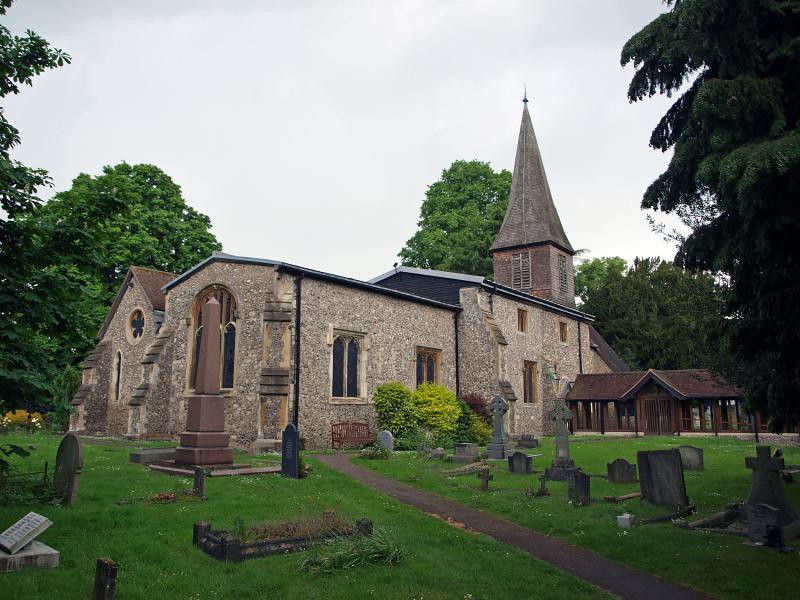ST STEPHEN. St Stephen, like St Michael, bears witness to those Early Norman decades when the cathedral was being rebuilt. The W front of the nave, of rough flint thickly embedded in mortar, has quoins of Roman brick and two small roundheaded windows. The front of the demolished N aisle which was left standing has one more such window. The N wall of the nave is a remarkable palimpset. It contains one large Early Norman window (splay only inside; otherwise one might have been tempted to assign to it a pre-Conquest date). This was blocked and cut into by a wide Norman arch, probably to the aisle, which is in style similar to the arcade at St Michael’s. It can hardly be later than c. 1120. This arch is also blocked. To the W of it an equally blocked pointed arch. Later, after the aisle had been pulled down, a pointed doorway was cut into the blocked roundheaded bay. The chancel masonry must also be Norman, as to it a S chapel was added early in the C13. The two S lancet windows are original. The s aisle arcade is again not of one date. The octagonal piers of the W bays have earlier moulded capitals than those farther E. The difference can easily be seen. The dates must be late C13 and early C14. The arches are of uneven width and height too, but all double-chamfered. In the C15 the W door was added and further odd additions were made in timber. Instead of a chancel arch there is a timber frame, and a similar timber frame at the W end carries a timber bell—turret, original even in the two—light timber bell—openings. — FONT. C15 with much figure carving of indifferent quality, small figures in cusped niches on the shapely demi—figures of angels with shields on the bowl. — LECTERN. Large Eagle Lectern of brass with an inscription: ‘Georgian Creichtown Episcopus Dunkeldensis.’ The inscription dates the lectern as between 1524 and 1543. - STAINED GLASS. Chancel N side by Hughes, c. 1866, rather pictorial and Raphaelesque; E window 1860, and S aisle window 1862, by Clayton & Bell. — PLATE. Chalice, Late Elizabethan; Salver, plated, 1718; Salver, 1789; Chalice, 1833. - MONUMENTS. Brass to William Robins d. 1482, wife and children (chancel N wall).
Nearly a mile from the city centre, St Stephen’s Church stands at the top of St Stephen’s Hill, at its meeting with King Harry Lane and Watling Street, which continued north-west through Verulamium. It is on the site of a Roman cemetery, and things brought to light in recent digging are in the Verularnium museum. In the churchyard of fine trees and hawthorn avenues is a Roman milestone, and there are Roman bricks in the oldest parts of the church. This is a charming picture, with its porch of stone and timber, and its quaint shingled tower and spire. The Saxon church almost vanished with rebuilding and alterations in Norman and medieval days, and most of the old work is 15th century, but some Norman masonry remains, and a blocked arch in the north wall of the nave is part of a 12th-century arcade which led to a lost aisle. Two small Norman lights are in the west wall. The south arcade is 13th and 14th century. On the pillars are old inscriptions and drawings and mason’s marks. One inscription tells of Edward Pearse, who was crushed under one of the stones, and another is said to have been cut by a Royalist soldier imprisoned here; there are men fighting, and a Crusader’s head. There are 13th-century lancets in the south chapel, whose interior, with leaning walls and a roof of old timbering, reminds us of a ship. It has a tiny peephole.
A rare feature is the oak chancel arch with traceried spandrels; it is chiefly modern, with some remains of the 15th century. The battered 500-year-old font has angels and shields on the bowl and the Madonna and saints on the stem. The brass eagle lectern, with three lions at the foot and an inscription to a Bishop of Dunkeld 500 years ago, is believed to have belonged to Holyrood Chapel at Edinburgh. It was buried for safety under the chancel during the Civil War, and found 100 years later. William Robins of 1482 is here with his family in brass, William in armour with a dog at his feet, his wife in her butterfly headdress. In beautiful modern glass we see a boy (with a dog at his feet) touching one of the wounds of St Julian, and the Saxon Abbot Ulsinus holding a little church, with the abbey for a background.
A rare feature is the oak chancel arch with traceried spandrels; it is chiefly modern, with some remains of the 15th century. The battered 500-year-old font has angels and shields on the bowl and the Madonna and saints on the stem. The brass eagle lectern, with three lions at the foot and an inscription to a Bishop of Dunkeld 500 years ago, is believed to have belonged to Holyrood Chapel at Edinburgh. It was buried for safety under the chancel during the Civil War, and found 100 years later. William Robins of 1482 is here with his family in brass, William in armour with a dog at his feet, his wife in her butterfly headdress. In beautiful modern glass we see a boy (with a dog at his feet) touching one of the wounds of St Julian, and the Saxon Abbot Ulsinus holding a little church, with the abbey for a background.

No comments:
Post a Comment